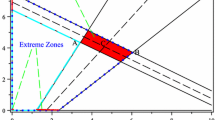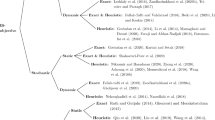Abstract
Interval analysis is a powerful tool which allows the design of branch-and-bound methods able to solve many global optimization problems. The key to the speed of those methods is the use of several tests to discard boxes or parts of boxes in which no optimal point may occur. In this paper we present three new discarding tests for two-dimensional problems which are specially suitable for planar single-facility location problems. The usefulness of the new tests is shown by a computational study.
Similar content being viewed by others
References
Berner, S. (1996), New Results on Verified Global Optimization, Computing 57: 323-343.
Casado, L.G., García, I. and Csendes, T., A New Multisection Technique in Interval Methods for Global Optimization, Computing (to appear).
Csallner, A.E. (1993), Global optimization in separation network synthesis, Hungarian Journal of Industrial Chemistry 21: 303-308.
Csendes, T. (1998), Optimization methods for process network synthesis-a case study. In Christer Carlsson and Inger Eriksson (eds.), Global multiple criteria optimization and information systems quality, Abo Academy, Turku, pp. 113-132.
Csendes, T. and Ratz, D. (1996), A review of subdivision direction selection in interval methods for global optimization, ZAMM 76: 319-322.
Csendes, T. and Ratz, D. (1997), Subdivision direction selection in interval methods for global optimization, SIAM Journal on Numerical Analysis 34: 922-938.
Drezner, Z. (1995), Facility Location: a Survey of Applications and Methods, Springer, Berlin.
Fernández, J. (1999), Nuevas técnicas para el diseño y resolución de problemas de localización continua (New techniques for design and solution of continuous location models), Ph.D. Thesis, Dpto. Estadística e Investigación Operativa, Universidad de Murcia, Murcia, Spain (in Spanish).
Fernández, J., Cánovas, L. and Pelegrín, B. (1997), DECOPOL-codes for decomposing a polygon into covex subpolygons, European Journal of Operational Research 102: 242-243.
Fernández, J., Cánovas, L. and Pelegrín, B. (2000), Algorithms for the decomposition of a polygon into convex polygons, European Journal of Operational Research 121: 330-342.
Fernández, J., Cánovas, L. and Pelegrín, B. (2000), Decomposition of a polygon with holes into convex polygons, Working paper 2000/2, Department of Statistics and Operations Research, University of Murcia, Murcia, Spain.
Fernández, J., Fernández, P. and Pelegrín, B. (1997), Estimating Actual Distances by Norm Functions: a Comparison between the l k;p ?-norm and the l b1;b2 ?-norm and a Study about the Selection of the Data Set, Computers and Operations Research (to appear).
Fernández, J., Fernández, P. and Pelegrín, B. (2000), A continuous location model for siting a non-noxious undesirable facility within a geographical region, European Journal of Operational Research 121: 259-274.
Fernández, J. and Pelegrín, B. (2000), Sensitivity Analysis in Continuous Location Models via Interval Analysis, Studies in Locational Analysis 14: 121-136
Goos, A. and Ratz, D. (1997), Praktische Realisierung und Test eines Verifikationsverfahrens zur Loesung globaler Optimierungsprobleme mit Ungleichungsnebenbedingungen, Forschungsschwerpunkt Computerarithmetik, Intervallrechnung und Numerische Algorithmen mit Ergebnisverifikation, technical report (available at http://www.unikarlsruhe. de/iam/html/reports.html).
Hansen, E. (1992), Global Optimization Using Interval Analysis, Marcel Dekker, New York.
Hansen, P., Peeters, D., Richard, D. and Thisse, J.F. (1985), The minisum and minimax location problems revisited, Operations Research 33: 1251-1265.
Hua, J.Z., Brennecke, J.F. and Stadtherr, M.A. (1998), Enhanced interval analysis for phase stability: cubic equation of state models, Industrial Engineering Chemical Research 37: 1519-1527.
Kearfott, R.B. (1996), Rigorous Global Search: Continuous Problems, Kluwer, Dordrecht.
Kearfott, R.B. (1996), Test results for an interval branch and bound algorithm for equalityconstrained optimization, in: State of the art in global optimization, Kluwer, Dordrecht, 181-199.
Kearfott, R.B. (1996), On Verifying Feasibility in Equality Constrained Optimization Problems, technical report (available at http://interval.louisiana.edu/preprints.html).
Kearfott, R.B. (1998), On Proving Existence of Feasible Points in Equality Constrained Optimization Problems, Mathematical Programming 83: 89-100.
Klatte, R., Kulisch, U., Neaga, M., Ratz, D. and Ullrich, C. (1992), PASCAL-XSC-Language Reference with Examples, Springer, Heidelberg.
Love, R.F., Morris, J.G. and Wesolowsky, G.O. (1988), Facilities Location: Models and Methods, North Holland, New York.
Plastria, F. (1992), GBSSS: The Generalized Big Square Small Square Method for Planar Single-Facility Location,European Journal of Operational Research 62: 163-174.
Rall, L.B. (1981), Automatic Differentiation, Techniques and Applications, Lecture Notes in Computer Science, No. 120, Springer, Berlin.
Ratschek, H. and Rokne, J. (1988), New Computer Methods for Global Optimization, Ellis Horwood, Chichester.
Ratschek, H. and Rokne, J. (1993), Experiments using interval analysis for solving a circuit design problem, Journal of Global Optimization 3: 501-518.
Ratschek, H. and Voller, R.L. (1991), What can Interval Analysis do for Global Optimization?, Journal of Global Optimization 1: 111-130.
Ratz, D. (1994), Box-splitting strategies for the interval Gauss-Seidel step in a global optimization method, Computing 53: 337-353.
Ratz, D. (1996), On Branching Rules in Second-Order Branch-and-Bound Methods for Global Optimization, in: Alefeld, Frommer and Lang (eds.), Scientific Computing and Validated Numerics, Akademie-Verlag, pp. 221-227.
Ratz D. and Csendes T. (1995), On the Selection of Subdivision Directions in Interval Branchand-Bound Methods for Global Optimization, Journal of Global Optimization 7: 183-207.
Author information
Authors and Affiliations
Rights and permissions
About this article
Cite this article
Fernández, J., PelegrÍn, B. Using Interval Analysis for Solving Planar Single-Facility Location Problems: New Discarding Tests. Journal of Global Optimization 19, 61–81 (2001). https://doi.org/10.1023/A:1008315927737
Issue Date:
DOI: https://doi.org/10.1023/A:1008315927737




